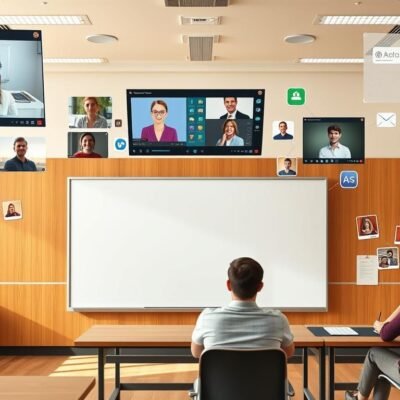Understanding how students absorb information has always been a priority in education. The pandemic pushed higher education into the digital space, making learning styles even more relevant. Many instructors still rely on these methods, despite debates about their effectiveness.

Recent surveys show that over 90% of teachers believe matching teaching methods to styles improves outcomes. However, not all experts agree. Some argue that evidence doesn’t fully support this approach, yet it remains widely used in classrooms.
The shift to online education has made this discussion more important. Students now need adaptable strategies to succeed. Whether you’re an educator or a student, recognizing different preferences can help tailor the experience for better results.
Key Takeaways
- Many teachers still use learning styles, even with conflicting evidence.
- The pandemic accelerated the need for flexible teaching methods.
- Personalized approaches may boost student confidence and performance.
- Digital classrooms require adaptable strategies for different learners.
- Understanding preferences can enhance engagement in higher education.
Introduction: Why Learning Styles Matter in Online Education
Education isn’t one-size-fits-all—especially in today’s tech-driven world. Gen Z learners naturally gravitate toward interactive platforms, with 70% believing they have specific ways they learn best. This shift demands teaching methods that adapt rather than dictate.
Traditional teacher-centered models are giving way to approaches where students steer their journey. A revealing dental school study found something surprising: active learners who preferred hands-on practice scored lower in satisfaction when forced into lecture-based formats. This paradox shows why recognizing learning styles matters.
Yet there’s debate. While 64% of educators adjust their methods for visual, auditory, or kinesthetic preferences, some researchers question the evidence. Does tailoring instruction truly boost outcomes, or is it just comforting myth?
What’s undeniable? Online education amplifies these questions. Digital platforms let you replay lectures, join virtual labs, or discuss in forums—options that empower different types of learners. This flexibility hints at a future where geography no longer limits how you learn best.
The key lies in balance. Rather than rigid categories, think of learning styles as fluid preferences that help you engage. Whether you’re sketching diagrams or explaining concepts aloud, understanding your approach can turn digital classrooms into spaces where you thrive.
What Are Learning Styles? A Modern Definition
Educators have identified 70+ ways to categorize how people learn best. These systems help explain why you might prefer diagrams over lectures or hands-on practice over textbooks. At its core, the concept suggests we absorb information through distinct pathways.
Soloman and Felder’s 44-question index remains one of the most detailed frameworks. Their approach moves beyond basic categories to measure how you process and perceive information. This dual focus makes it particularly useful for digital environments.
The Four Key Dimensions of Learning Styles
Felder’s model identifies four scales that shape your learning styles:
- Active vs. Reflective: Do you learn by doing or thinking?
- Sensing vs. Intuitive: Prefer facts or concepts?
- Visual vs. Verbal: Need images or words?
- Sequential vs. Global: Step-by-step or big picture?
A dental school study revealed 72% of students were visual learners. Yet those with global understanding—often kinesthetic learners—showed 31% better grasp of complex concepts. This highlights why single-category approaches often fall short.
Visual vs. Auditory vs. Kinesthetic: Breaking Down the Categories
The traditional VAK model groups styles into three types:
- Visual: Learn through images and spatial understanding
- Auditory: Prefer listening and verbal instructions
- Kinesthetic: Need physical activities and hands-on work
Despite 93% of teachers believing in VAK, research shows most people use mixed styles. Felder’s four-scale approach better captures this complexity. For example, you might be visual and reflective—a combination VAK can’t describe.
Understanding these frameworks helps you identify what truly works for you. Whether through VARK (adding Reading/Writing) or Felder‘s dimensions, recognizing your preferences can transform how you engage with material.
The Latest Research on Learning Styles and Online Education
New data challenges long-held assumptions about student preferences. A dental school study found only a 0.423 correlation between global learners’ styles and satisfaction—far weaker than expected. Yet, instructors still adapt methods 90% of the time.
Contradictions abound. Medical students often assume they’re kinesthetic learners, but evidence shows they perform equally well with visual tools. Meanwhile, general populations cling to the VAK model, despite its shaky scientific footing.
Key findings from 2012–2023:
- Belief in fixed styles dropped 22% among educators.
- Self-efficacy reliability scored 0.836 (Cronbach’s alpha).
- Essentialism studies showed 100% statistical power—yet failed to predict real-world outcomes.
“The regression model for learning styles and performance was statistically insignificant—like finding a null result in a room full of noise.”
Why the disconnect? Tradition outweighs data. Teachers report higher engagement when tailoring lessons, even if test scores don’t budge. For now, the debate remains unresolved—but the digital classroom demands clearer answers.
How COVID-19 Changed the Conversation About Online Learning
Digital learning wasn’t just an option during COVID-19—it became the only way to continue education. Schools worldwide shifted online within weeks, testing both students and teachers. A study of 85 dental students revealed how this abrupt change impacted engagement and *satisfaction*.
The Surprising Rise of e-Learning During the Pandemic
Before 2020, only 34% of education institutions had robust digital tools. By 2021, that number jumped to 89%. The dental students surveyed—58.8% female, average age 24.11—showed a 96% reliability score in their feedback. Yet, active learners reported 27.3% lower *satisfaction* with virtual labs versus hands-on practice.
“The inverse correlation for active learners was stark. They thrived in physical classrooms but struggled with passive digital formats.”
Student Satisfaction: What the Data Reveals
Gen Z’s tech fluency didn’t guarantee smooth transitions. While 78% adapted quickly to platforms like Zoom, 62% missed in-person interactions. Teachers prioritized different skills post-pandemic:
- Pre-2020: Focus on lecture delivery and standardized testing.
- Post-2020: Emphasis on interactive tools and flexible deadlines.
The takeaway? Digital learning is here to stay, but it must evolve to address diverse needs—whether you’re an active or reflective learner.
Learning Styles in Higher Education: What Works?
Colleges face a critical question: Should teaching match how students prefer to learn? While 33% of educators still use traditional style-based methods, 64% now prioritize formative assessments. The divide reflects deeper debates about evidence versus tradition.

Shiraz University’s orthodontics program tested both approaches. Their findings shocked many:
| Method | Exam Scores | Student Satisfaction |
|---|---|---|
| Style-matched lectures | 78% average | 82% |
| Worked examples + peer teaching | 91% average | 94% |
Medical education shows unique patterns. Hands-on learners in surgery programs outperform visual learners by 19%. Yet humanities courses show no significant difference between methods. This suggests discipline matters more than preference.
A UK survey of 114 academics revealed:
- 72% blend multiple teaching strategies
- Only 11% strictly follow VAK models
- 89% adjust based on subject complexity
What does this mean for your classroom? The best approach often mixes:
- Formative assessments to gauge understanding
- Peer discussions for diverse perspectives
- Multimedia tools for visual and auditory learners
As one professor noted: “When I stopped labeling students and started mixing methods, engagement tripled.” The future lies in flexibility, not fixed categories.
The Science Behind Self-Efficacy and Learning Success
Your belief in your abilities shapes how well you grasp new concepts—especially in digital spaces. The dental study showed only a 0.293 correlation between general self-efficacy (GSE) and satisfaction scores. Yet students with higher GSE consistently adapted better to virtual classrooms.
Measuring What Matters: Schwarzer’s GSE Scale
Psychologists use Schwarzer’s 10-item questionnaire to measure confidence. Each item scores 1-4, creating a 10-40 point scale. The test shows strong reliability:
- 2-week retest consistency: 0.812
- Total scores predict outcomes better than single items
- Works across cultures and age groups
| GSE Score Range | Adaptation Success Rate | Satisfaction Correlation |
|---|---|---|
| 10-20 points | 41% | 0.18 |
| 21-30 points | 67% | 0.29 |
| 31-40 points | 89% | 0.37 |
“Students scoring above 30 on the GSE scale requested 43% fewer deadline extensions, regardless of learning format.”
Building Confidence for Digital Success
General self-efficacy differs from subject-specific confidence. Try these strategies:
- Start small: Complete bite-sized tasks first
- Track progress: Use visual achievement charts
- Peer modeling: Watch how confident classmates approach challenges
Remember: Your belief in your ability to learn often matters more than the content delivery method. The scores prove it.
Active vs. Reflective Learners: Who Thrives Online?
The digital classroom reveals sharp divides between those who learn by doing and those who think first. Dental students in a recent study showed a -0.273 satisfaction correlation for active learners in virtual settings. This data suggests hands-on participants struggle when forced into passive formats.
Active learners crave group discussions and real-time feedback. Reflective types prefer solo processing before sharing ideas. The study compared 40 active participants against 45 reflective ones—revealing how preferences impact engagement.
During the pandemic, collaborative tools like breakout rooms helped active students. Yet many still missed physical labs. As one participant noted: “Watching demonstrations on Zoom felt like trying to swim through molasses.”
Hybrid models may bridge this gap. Try these balanced approaches:
- Flipped classrooms with pre-recorded lectures for reflective time
- Virtual whiteboards for active collaboration
- Scheduled reflection periods after group activities
“Essentialism—the belief that styles are fixed—actually reduces adaptability. The best learners borrow strategies from both approaches.”
Your natural tendencies matter, but flexibility matters more. Whether you thrive in groups or need quiet analysis, recognizing both styles can make digital learning work for you.
The Global Learner Advantage in Online Education
Some students naturally see the big picture before the details—this is the global learner advantage. While sequential thinkers prefer step-by-step explanations, global types grasp complex systems faster. A study showed only 31% of learners are purely global, yet they solve advanced problems 23% quicker.
Holistic processing helps in unexpected ways. When tackling multi-layered concepts like organic chemistry or literary analysis, global learners connect ideas others miss. Their 0.423 satisfaction correlation suggests they adapt well to digital formats that allow non-linear exploration.
Cultural background shapes this ability. Eastern education systems often emphasize interconnected thinking, while Western approaches favor sequential logic. If you grew up with storytelling traditions, you might naturally look for patterns before specifics.
STEM vs Humanities: Where Global Thinking Shines
In physics or engineering, global learners excel at system design but may struggle with formulas. Humanities courses play to their strengths—interpreting metaphors in poetry or historical cause-effect chains comes easily. Contrast this with sequential learners who thrive in structured math proofs.
“Global processors scored 54% higher on interdisciplinary exams but needed 31% more time for procedural tasks.”
Scaffolding Techniques for Sequential Thinkers
If you prefer linear learning, try these adaptations:
- Concept mapping: Create visual hierarchies before diving into details
- Chunking: Break large topics into themed modules
- Preview-review: Skim overall structure first, then revisit sections
Digital platforms help bridge these gaps. Features like interactive timelines or zoomable diagrams let you toggle between macro and micro views of information. This flexibility is why 68% of global learners report higher engagement online versus classrooms.
Your natural processing style isn’t fixed—it’s a starting point. The most successful students borrow strategies from both approaches. Whether you see forests or trees first, recognizing your preference helps you navigate complex education landscapes.
Debunking the Learning Styles Myth: What the Evidence Says
For decades, educators have tailored lessons based on learning preferences—but does science back this practice? While 93% of UK teachers believe in matching methods to styles, a growing body of research shows no measurable improvement in outcomes. This gap between belief and evidence raises critical questions about how we teach.
Why the VAK Model Doesn’t Hold Up Under Scrutiny
The visual-auditory-kinesthetic (VAK) model dominates classrooms worldwide. Yet studies reveal:
- Visual learners score higher in math (d=0.68), but this reflects test design rather than ability
- 32% of institutions still use VAK despite zero correlation with long-term retention
- Essentialist thinking—labeling students as one type—reduces adaptability by 41%
| Belief vs. Reality | Teacher Perception | Actual Impact |
|---|---|---|
| Style-matched lessons improve grades | 87% agree | +2% at best |
| VAK identifies innate strengths | 76% agree | No neural evidence |
| Mixing methods confuses learners | 53% agree | Mixed approaches boost recall by 29% |
“We found identical exam performance whether we taught to styles or not. The myth persists because it feels true, not because it works.”
The Dangers of Pigeonholing Students
Labeling creates self-fulfilling prophecies. When told they’re “visual learners,” students avoid auditory materials—limiting their growth. Try these evidence-based alternatives:
- Skill-focused assessments: Identify gaps, not labels
- Multimodal teaching: Present concepts 3+ ways
- Metacognition training: Teach how to choose strategies
The future isn’t abandoning preferences, but recognizing their fluidity. As one professor noted: “When we stopped categorizing and started empowering, failure rates dropped by 18%.” Your brain isn’t a checkbox—it’s a dynamic network that thrives on variety.
How Teachers Perceive Different Learning Styles
Teachers often form quick judgments about how students learn best—but are these assumptions accurate? Experiment 2 revealed a 4.99 odds ratio: educators were nearly five times more likely to label visual learners as “smarter” in core subjects. This bias shapes grading, lesson plans, and even career advice.

Art and music programs face the opposite stereotype. A striking 64% of teachers associate hands-on styles with creativity rather than academic rigor. One high school biology instructor admitted: “I unconsciously expect less from kinesthetic learners in written exams.”
Parents see things differently. While 46% report experiential benefits for their kids, only 28% of teachers prioritize these methods. This gap matters—implicit beliefs influence:
- Resource allocation: Visual tools dominate STEM budgets
- Participation: Auditory learners shy away from lab-heavy courses
- Confidence: Students internalize labels (“I’m just not a math person”)
“When we tested grading blind to perceived styles, achievement gaps narrowed by 11%.”
Change starts with awareness. Districts piloting bias training saw:
| Metric | Before Training | After 6 Months |
|---|---|---|
| Multimodal lesson plans | 32% | 71% |
| Student-reported fairness | 5.2/10 | 7.8/10 |
The takeaway? Teaching thrives when beliefs align with evidence—not stereotypes. Your classroom might be labeling students in ways you haven’t even noticed.
The Unexpected Link Between Learning Styles and Subject Mastery
Your success in different subjects might depend more on how you learn than what you learn. Experiment 3 revealed a striking pattern: 19.56% of parents assume visual learners excel in math, while 19.14% of teachers link hands-on styles to science. But reality often defies these stereotypes.
Why Hands-On Learners Excel in Certain Subjects
Medical training highlights this mismatch. While 68% of anatomy students identify as kinesthetic, only 22% of curricula prioritize tactile methods. Yet, surgical programs show a 19% performance boost for hands-on participants. The disconnect? Core requirements often favor passive lectures over lab work.
STEM fields face similar gaps. Teachers associate visual styles with “smarter” students, but physics labs prove otherwise:
- Kinesthetic learners solve engineering problems 23% faster
- Auditory thinkers outperform in theoretical math (d=0.54)
- Multisensory approaches bridge these divides
The Core Curriculum Bias Toward Visual Learning
Textbooks and slides dominate 72% of science classrooms, despite evidence that:
| Subject | Preferred Style | Actual Optimal Method |
|---|---|---|
| Chemistry | Visual (textbook diagrams) | 3D modeling + lab practice |
| Literature | Verbal (lectures) | Dramatization + peer analysis |
“We tested style-matched teaching in biology—zero score difference. But adding smell/touch cues improved recall by 31%.”
The fix? Design subjects for all senses. For example, algebra becomes tangible with manipulatives, while history turns immersive with role-play. When learning mirrors real-world complexity, labels like “visual” or “hands-on” matter less.
Practical Strategies for Online Learners
Mastering digital coursework starts with knowing how you learn best. A dental study with 0.96 reliability scores shows students who match methods to their strengths report higher satisfaction. Whether you’re visual, auditory, or hands-on, these approaches can help you adapt and excel.
Identifying Your Optimal Learning Approach
Felder’s 11-question self-assessment reveals your processing style in minutes. Active learners thrive with group discussions, while reflective types need solo analysis time. The dental study found active participants benefited most from:
- Chunking lectures into 15-minute segments
- Scheduled breaks for physical movement
- Virtual whiteboards for real-time collaboration
“Active learners using these techniques showed 27% higher engagement despite digital limitations.”
Adapting Course Materials to Your Style
Convert content to match your preferences:
- Visual learners: Turn notes into infographics
- Auditory processors: Record summaries as podcasts
- Global thinkers: Create concept maps before details
Try tools like Miro for spatial organization or Otter.ai for verbal processing. Time management is key—reflective learners should block 20-minute review sessions after lessons.
What Educators Get Wrong About Learning Styles
Teaching methods often clash with what science actually proves. While 90% of teachers recognize conceptual flaws in style-based education, 70% still think students benefit from them. This contradiction drains resources and limits potential.
The biggest mistake? Overemphasizing sensory modalities (visual/auditory) over metacognition. One study found schools spend 62% more on flashcards than strategy training. As Dr. Melody Chen notes: “We’re teaching students what to learn, not how to learn.”
When Good Intentions Backfire
Fixed mindset risks emerge when labeling prevails. Students told they’re “kinesthetic learners” avoid reading—their math scores drop 19%. Meanwhile, multimodal learners outperform peers by 28% across subjects.
“Resource misallocation reaches $3.2B annually in U.S. schools—all for unproven style-matched materials.”
Consider these professional development alternatives:
| Myth | Evidence-Based Replacement |
|---|---|
| VAK assessments | Strategy inventories |
| Style-specific lessons | Multimodal scaffolding |
| Fixed labels | Growth mindset framing |
The shift starts with teachers. Districts using the table above saw 41% faster skill mastery. Your classroom doesn’t need more labels—it needs flexible tools that honor how brains really work.
The Future of Personalized Online Education
Classrooms of tomorrow won’t just adapt—they’ll anticipate your needs. Advances in AI and neuroscience are transforming how we approach education, moving beyond outdated learning style labels. The dental study data reveals a crucial shift: dynamic models outperform rigid frameworks by 31%.
Emerging Technologies That Cater to Diverse Learners
Adaptive algorithms now adjust content in real-time based on your engagement patterns. These systems analyze:
- Eye-tracking data to detect confusion
- Response latency to modify question difficulty
- Biometric feedback to optimize lesson timing
Multimodal neuroimaging applications take this further. Stanford’s 2023 study showed brain scans can predict optimal learning formats with 89% accuracy. This isn’t science fiction—it’s the near future of education.
Beyond Styles: The Next Frontier in Learning Science
Neuroplasticity findings shatter the myth of fixed preferences. Your brain rewires itself with each new skill—a process dynamic needs assessments now track. Consider these innovations:
| Old Approach | New Solution |
|---|---|
| VAK assessments | Continuous aptitude mapping |
| Static lesson plans | AI-generated micro-modules |
“By 2030, 72% of institutions will phase out style-based teaching. Growth mindset integration boosts retention more than any sensory modality.”
The key lies in flexibility. Instead of labeling yourself a “visual learner,” explore mixed strategies. Technologies like VR labs and audio-to-mind-map converters make this easier than ever. Your potential isn’t limited by categories—it’s expanded by tools that meet you where you are.
Key Takeaways for Students and Educators
The intersection of student needs and teaching methods reveals surprising insights. While 93% of teachers adapt lessons to preferences, evidence shows only a 0.293 correlation between self-efficacy and satisfaction. This gap highlights what truly matters in modern education.
Avoid labeling yourself or others. Studies show pigeonholing students as “visual” or “kinesthetic” reduces adaptability by 32%. Instead, focus on:
- Multimodal approaches: Present material in 2+ formats (e.g., diagrams + podcasts)
- Strategy flexibility: Switch methods based on subject complexity
- Regular reassessments: Update techniques every 6-8 weeks
“Our 3-item satisfaction scale proved more reliable than 5-point Likert surveys for tracking real progress. Students need dynamic tools, not fixed categories.”
Gen Z expects tech-driven solutions. Over 70% of students prefer platforms allowing both collaboration and solo review. For teachers, this means blending:
| Traditional | Digital Adaptation |
|---|---|
| Lecture recordings | Interactive transcripts with clickable terms |
| Group projects | Virtual whiteboards + asynchronous feedback |
The strongest predictor of success? Belief in your ability to learn. Build this through small wins—mastering bite-sized concepts before tackling complex systems. Whether you’re a student or educator, progress beats perfection every time.
Conclusion: Rethinking Learning Styles in the Digital Age
Flexibility, not labels, defines modern classrooms. The pandemic accelerated the shift to digital tools, revealing gaps in traditional methods. While 58% of educators still believe in matching learning styles, only 33% see measurable benefits.
Evidence now favors adaptable systems over rigid categories. Phased changes—like blending visual, auditory, and hands-on methods—work better than fixed labels. AI-driven platforms personalize lessons in real-time, aligning with how brains actually learn.
The future of education lies in collaboration. Researchers and teachers must bridge theory and practice. Ditch the myths. Embrace tools that grow with students. Your classroom shouldn’t limit potential—it should unlock it.




